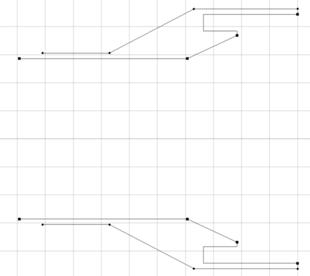7-3.4 Scrimp Horn
A short axially corrugated horn with a single slot and a cylindrical extension radiates in the hybrid mode and produces suitable patterns over a waveguide band. The gain ranges from 10.9- to 13.3-dB. By using an input radius , a flare angle of 25°, a slot pitch of λc/8, and δ = 0.8, a series of horns were designed using the optimization in CHAMP (TICRA), a mode matching analysis program using minmax optimization to generate designs that produce the hybrid mode. The currents excited on the external surface of the horn must be included in the optimization because of the low gain. The design parameters are listed in Table 1.
, a flare angle of 25°, a slot pitch of λc/8, and δ = 0.8, a series of horns were designed using the optimization in CHAMP (TICRA), a mode matching analysis program using minmax optimization to generate designs that produce the hybrid mode. The currents excited on the external surface of the horn must be included in the optimization because of the low gain. The design parameters are listed in Table 1.
Download complete report Scrimp_Horn_Design.

Figure 1 CHAMP Design of Scrimp Horn Geometry 0.74λ Outer Radius
Table 1 Scrimp Horn Designs with dimension, λc
Outer Radius |
Gain dB |
10 dB Beamwidth |
Slot Depth |
Axial Extension |
Cross Polarization |
0.62 |
10.86 |
102.8 |
0.2317 |
0.1599 |
39.8 dB |
0.64 |
11.09 |
99.9 |
0.2344 |
0.1676 |
41.4 |
0.66 |
11.30 |
97.3 |
0.2292 |
0.1785 |
42.7 |
0.68 |
11.51 |
94.9 |
0.2241 |
0.1924 |
44.2 |
0.70 |
11.96 |
88.8 |
0.2097 |
0.3415 |
30.9 |
0.72 |
12.05 |
88.5 |
0.2151 |
0.2760 |
36.4 |
0.74 |
12.34 |
85.1 |
0.2004 |
0.3600 |
30.5 |
0.76 |
12.57 |
83.0 |
0.2031 |
0.3659 |
31.2 |
0.78 |
12.78 |
81.0 |
0.2032 |
0.3752 |
31.8 |
0.80 |
13.11 |
77.8 |
0.2070 |
0.4078 |
30.9 |
0.82 |
13.15 |
77.7 |
0.2000 |
0.3870 |
36.3 |
0.84 |
13.33 |
76.2 |
0.1990 |
0.3960 |
38.6 |